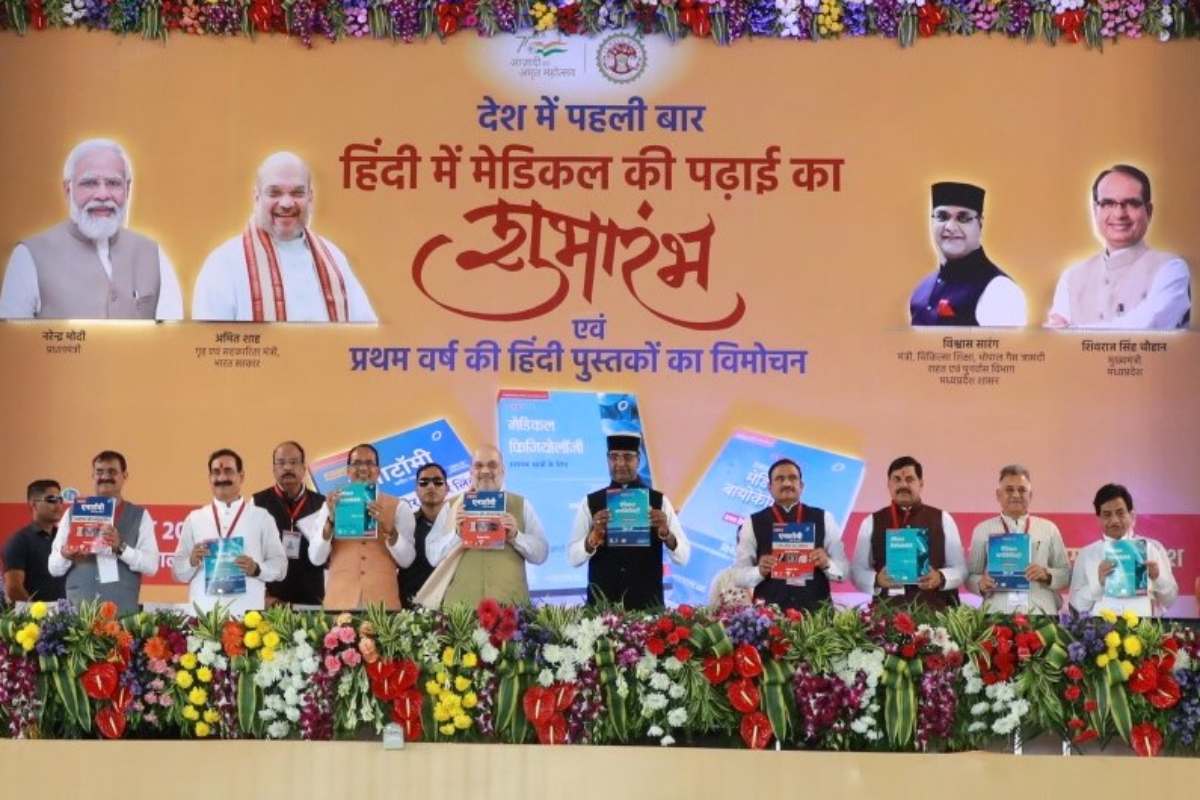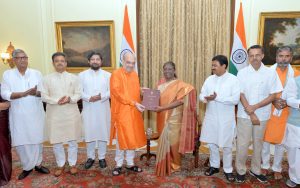Successive governments have presented the official language data in such a way that it shows a constant growth in number of Hindi speakers. Since 1971, several other languages have been brought under the rubric of Hindi.

Union Minister of Home Affairs Amit Shah launches an MBBS book in Hindi on 16 October (Twitter/CMMadhyaPradesh)
During the pre-Independence era, the Congress had set up its provincial committees along linguistic lines. After 1927, the election manifestos of the Congress often included preservation of multiple linguistic identities as one of its obligations.
By this time, the 11 volumes of Grierson’s massive Linguistic Survey of India had been published. It was well-known to the opinion makers that India had at the beginning of the twentieth century an amazing wealth of languages. Grierson had detailed 189 languages and several hundred others considered by him as ‘dialects’.
The debates in the Constituent Assembly were, therefore, mindful of the need to imagine India as a nation with many languages and the dangers in straight-jacketing it within a monolingual or bilingual administrative apparatus.
Not surprisingly, the Constitution initially made space for 14 languages in its Eighth Schedule as specially designated languages, the Scheduled Languages. Through a series of additions to the list, the number of Scheduled Languages at present is 22.
The years from 1947 to 1956 were quite tumultuous from the language perspective. First, there was a committee set up in 1948 by Rajendra Prasad to examine if linguistic states would be a viable idea. Then, another committee set up the same year that included Jawaharlal Nehru, Vallabhbhai Patel, and Pattabhi Sitaramaya examined the proposition.
Dr BR Ambedkar too submitted a memorandum asking for a state for Marathi. Potti Sreeramalu, asking for an Andhra Pradesh for Telugu, died in a fast unto death.
Finally, a States Reorganization Commission was appointed in 1955. On its recommendations, several states were created with language as the core of the state identity.
However, throughout this process, the idea of India as a nation with many languages had been firmly accepted by the people, the state, and most importantly was enshrined in the Constitution. Five years later, when the Census for 1961 was conducted, it showed a remarkable degree of confidence in the idea by listing 1,652 mother tongues as being in existence and claimed by the people of India as their mother tongues.
As a result of the extensive debates on the language issue, the Constitution took an extremely nuanced stand on the language issue.
Article 120 provided for the use of Hindi or English for business in Parliament.
Article 210 provided for the use of the state language or Hindi/English for the business of State Assemblies.
Article 344 provided for a Language Commission for the upkeep of all languages included in the Eighth Schedule.
Article 343 stipulated a fixed period of 15 years for replacing English with Hindi, but in a sub-clause, also provided for further extending the period if such an extension was found necessary.
Article 347 empowered the President to recognise any languages not included in the Eighth Schedule as ‘State Languages’ if a substantial number of people made such a demand.
Thus, while the Constitution laid down the objective of replacing English with Hindi, it also underscored the improbability of doing so within a very short period and also validated the democratic aspiration of various language communities to have their languages included in the Eighth Schedule or, at least, recognised as the ‘state languages’ within their own state.
By accepting language as the backbone in the state reorganisation process soon after Independence, the Government of India clearly upheld the idea of a nation that can be one but speaks in many different tongues.
This is not to say that the promotion of Hindi as a possible replacement for English was overlooked. That objective was indeed stated many times in speech and through grant-making policy.
A Hindi ‘kosh’ (compendium) for providing terminology was mooted and a yearly Hindi week was made mandatory. It is another matter that the ‘kosh’ soon became a butt of ridicule owing to its preference for Sanskrit-based terminology that was found literally unpalatable and ignored the ease of communication.
Language, like other prominent identity markers, is an emotive issue.
No government so far has had the courage to openly accept that a complete replacement of the English language by Hindi in the working of the Parliament and administration, in the communication between the states and the Centre, in higher education and research, and in industry and business is a near impossibility. Therefore, successive governments have presented the official language data to show a constant growth of Hindi.
In 1971, 20.28 crore was reported as Hindi-speaking out of the 54.82 crore population.
In successive Census counts, the figures for Hindi were shown to be on a steady rise:
1981, 25.77 crore out of 66.52 crore
1991: 32.95 crore out of 83.86 crore
2001: 42.20 crore out of 102.86 crore
2011: 52.83 crore out of 121.08 crore
The decadal growth was placed at 36.99 percent (1971), 38.74 percent (1981), 39.29 percent (1991), 41.03 percent (2001), and 43.63 percent (2011).
What the Census does not mention is that since 1971, several other languages have been brought under the rubric of the Hindi language. The 1,652 ‘mother tongues’ mentioned previously were reduced to a mere 108 ‘languages’ by introducing a cut-off point of 10,000 for any group of speakers to have their ‘mother tongue’ listed in the published data.
The cut-off point has no scientific basis either in linguistics or in statistics. Its justification is drawn from the politics of electoral democracy.
It would be interesting to see the language data of the most recent Census that was carried out in 2011. In it, the speakers who claimed Hindi as their mother tongue totalled 32.22 crore. But in order to bolster it up, the following 54 other languages — most of them completely independent as languages and some like Banjari even mutually unintelligible with Hindi — were shown as subsets of Hindi:
If one were to take these out of the Hindi language, the ratio between the total population under the Census, 121.08 crore, and the population of the Hindi speakers, 32.22 crore, is just a little less than 4:1.
All of this cold data, otherwise fairly uninteresting, goes to show why no government so far has been able to replace either the regional languages or English entirely with Hindi.
India has traditionally been a multilingual area. Neither the Sanskrit language in ancient India nor Persian during the 17th century was able to displace the large variety of languages that Indians had been using for communication and imaginative expression.
During colonial times, the English language entirely replaced the native languages of North America and Australia. But despite such efforts, it did not displace Indian languages.
On the contrary, the contact with Sanskrit strengthened Prakrits, the contact with Arabic and Persian brought rich vocabulary — bounty to Indian languages — and the presence and influence of English resulted in an unprecedented efflorescence of literature in Indian languages.
The open spaces and ambivalence in the Constitution on the language issue is a testimony to the deep understanding of the cultural and social history of India.
The BJP has made the formula ‘Hindi, Hindu, Hindustan’ its main political plank. Whereas numerically the Hindu population in India is overwhelmingly larger than the population professing other religions, that is not exactly the case with the Hindi-speaking population in relation to the population speaking other languages.

The Union Minister for Home Affairs and Cooperation Amit Shah and the members of the Committee of Parliament on Official Languages submitted the 11th Report of the Committee of Parliament on Official Languages to President Droupadi Murmu in New Delhi on 9 September 2022 (PIB)
Hindi is neither the oldest among the major Indian languages — Tamil, Telugu, Kannada, Marathi, Gujarati, Kashmiri, and Bangla having a much longer past — nor is it the richest in terms of literary production — many others including Kannada, Bangla, Marathi, and Malayalam being more or equally prolific and with varied literary genres.
Therefore, as an instrument to divide the Indian voters in terms of a large majority against a smaller minority, the Hindi language does not offer as deadly a strategy as Hindutva may offer.
It is not surprising that Amit Shah’s posturing in relation to the Hindi language from time to time meets with a backlash from most parts of India.
It would be naïve to believe that the BJP expects anything but such a backlash. Probably, the posturing is more for assuaging the unemployed youth in the Hindi belt and the voters there, in the context of the economy which has not stopped sliding downward. In a way, the expressed love for Hindi is an indirect confirmation that voter support, even in the Hindi heartland, is not guaranteed forever.
When one starts looking at the question of Hindi’s claim to be recognised as the language to replace English, the following four obvious factors need to be taken into consideration.
1. Hindi is not the natural language of a majority of states in India. These include Kerala, Tamil Nadu, Andhra Pradesh, Telangana, and Karnataka in the south; Goa, Maharashtra, and Gujarat in the west; Punjab and Jammu & Kashmir (currently a Union territory) in the north-west; Odisha and West Bengal in the east; Sikkim, Arunachal Pradesh, Mizoram, Tripura, Nagaland, Manipur, Meghalaya, and Assam in the north-east. These make 19 of the existing 28 states.
2. Of the remaining, Himachal Pradesh, Uttarakhand, Rajasthan, Bihar, Jharkhand, and Chhattisgarh are seen as predominantly Hindi-speaking states. But a closer look at their linguistic composition shows that they all have their own native regional languages within each of them and Hindi functions there as a shared pan-state language.
3. In terms of heritage value, Tamil, Kannada, Telugu, Malayalam, Marathi, Gujarati, Sindhi, Kashmiri, Odia, Bangla, Nepali, and Assamiya have a historically longer legacy than the Hindi language.
4. The Constitution has imagined India, both through commission and omission, as a multilingual country and not as a monolingual nation. The fact that it initially decided to list 14 languages in the Eighth Schedule clearly indicates the unwillingness of the makers of the Constitution to tether India to any single language.
Language issues are not to be sorted out only in terms of their numerical strength. Had that been the case, Chinese Mandarin would long back be accepted as the most viable international language. Every language is the common heritage of humanity. Every language is a unique way of looking at the world, a world-view.
(G N Devy is Chairman, People’s Linguistic Survey of India)